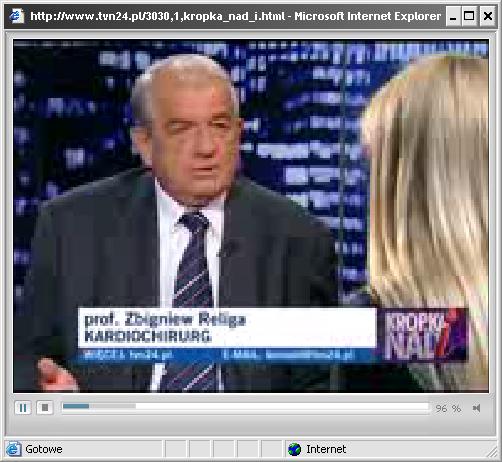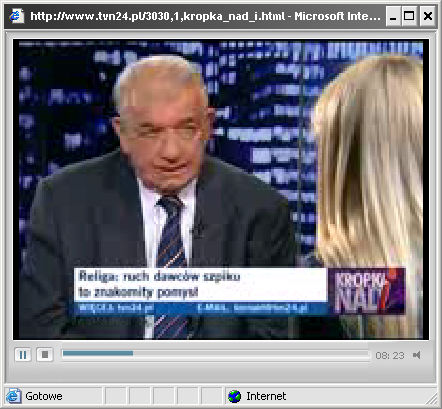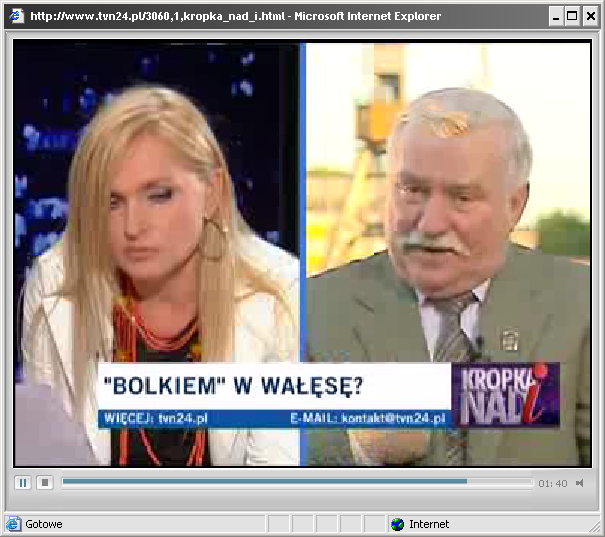UNIWERSYTET KAZIMIERZA WIELKIEGO
W BYDGOSZCZY
NAUCZYCIELSKIE KOLEGIUM JĘZYKÓW OBCYCH
W KOSZALINIE
SPECJALNOŚĆ: JĘZYK ANGIELSKI
Anna Czarnecka
Komunikacja werbalna i niewerbalna w polityce
na podstawie wywiadów Moniki Olejnik
Praca dyplomowa
napisana pod kierunkiem
dr Anny Bączkowskiej
Koszalin 2008
UNIWERSYTET KAZIMIERZA WIELKIEGO
W BYDGOSZCZY
NAUCZYCIELSKIE KOLEGIUM JĘZYKÓW OBCYCH
W KOSZALINIE
SPECJALNOŚĆ: JĘZYK ANGIELSKI
Anna Czarnecka
Verbal and Nonverbal Communication in Politics,
the case of Monika Olejnik's interviews
Praca dyplomowa
napisana pod kierunkiem
dr Anny Bączkowskiej
Koszalin 2008
Table of contents:
INTRODUCTION
In this work I intend to explain the main aspects of verbal and non-verbal communication of people by focusing on Polish politics behaviour during the interview guided by Monika Olejnik.
In the first chapter I explain the basic definitions of communication models and list and consider the Grice Maxims. I give the categorisation of non-verbal messages that the speakers send to the receiver. In the chapter one I also focus on the subject of speakers' attitude to the topic called positive and negative face.
Later in chapter two I present several pictures taken from the interview. I consider the interviewees' non-verbal behaviour in comparison to the situation and their verbal expressions. I analyze their gestures and postures as well as their attitude to the topic and the speaker in discussion.
CHAPTER I
Verbal and nonverbal communication definitions
General intention of this chapter is to explain what communication is and non-verbal communication in particular. Later, the communication models used in politics and in regular life are presented. An attempt to explain the Grice's maxims is made. Finally, the speech acts are compared to negative and positive face.
Communication models
According to Richmond and McCroskey (2000:1) “communication is the process of one person stimulating meaning in the mind of another person by means of verbal and/or non-verbal messages”. While verbal communication is the process of speaking, the non-verbal communication is the process of one person stimulating meaning in the mind of another person or persons by means of nonverbal messages.
Verbal messages are dependant on the language, while nonverbal messages do not demand the presence of any language. This may suggest that nonverbal communication is a communication without words. As the language is a system of coding the meaning by words it may be understood only by people who share the common language. On the contrary, the nonverbal behavior in most cases is not the part of any coding system.
Verbal messages are discontinuous, which means that speaker says words and stops and than says again. Nonverbal behavior never stops. Even while asleep, human body sends nonverbal massages. The absence of behavior sends a message just as much as the presence. In front of another human being one cannot not to communicate.
Nonverbal messages serve primarily an affective, relational or emotional function. The content of what we say is communicated by the verbal message. Both types of communication (verbal and nonverbal) are often important to the success of the communication between persons. To create a positive attitude the verbal communication alone may not be enough. Therefore, verbal and nonverbal components of communication are necessary for a receiver to get the entire message and understand the meaning behind it.
William Dwight Whitney claimed (in Załazińska 2006: 55) that “language is a way of expressing human's thoughts. It's unlimited and identified not only with verbal speech”. According to that definition, some scholars (Załazińska 2006: 56) state that there are four models of communication.
First of them is the code model that base on presume that there are some sources and recipients of coded information that was sent through some kind of a channel. The recipient that is a target point of sending information decodes the information included in the message due to the knowledge of the code. The source and the code are in some way included in the brain of the sender. The process of deciding takes place in the brain of the recipient. This model presumes that information that is coded will be decoded. That is why communication is commonly called as a process of sending information.
This model, however, does not mirror the real communication. It does not consider that the same information may be understood differently by its sender and recipient. Code models do not take under consideration context that may have an impact on the change in meaning.
Therefore, intentional models have been defined. They assume that the meaning of a message is dependant on speaker's intentions: he chooses from many different possibilities wording that expresses his intentions in a way that best gives what he meant. Recipient's role is to decode the meaning literally and in process of inference understanding speaker's communicative intensions. The role of context in such case is essential.
Perspective accepting model assumes that due to the subjectivism of the point of view of communication participants, they have to work out a mutual context or understanding area in order to understand each other. To achieve this they accept the perspective of the other side. In other words - they try to imagine the situation that is the situation of the other conversation participant.
Dialogue model are different from others by focusing on the role that a target participant of communication has. Modes mentioned before had two things in common. Firstly, the speaker's aim was to create a speech that would adequately transfer the single meanings. Secondly, the task of a listener is to receive the speech - to identify the speaker's aim.
Dialogue model analyze communication always according to primal face to face dialogue. From this point of view communication is not information exchange between two identical speech transmitters but most of all it is a mutual work of participants that cooperate to achieve a communicational goal. This mutual understanding, meaning negotiating is being worked out in every communication all over from the beginning.
Grice Maxims
As Brown and Levinson say (1987: 94) the Grice Maxims are an intuitive characterization of principles that would constitute guidelines for achieving maximally efficient communication. They may be divided into Maxim of Quality: be non-spurious (speak the truth, be sincere), Maxim of quantity: don't say more than required and don't say less than is required, Maxim of relevance: be relevant, Maxim of manner: be perspicuous, avoid ambiguity and obscurity.
These maxims define the basic set of assumption underlying every talk exchange. But this does not imply that utterances in general. The majority of natural conversations do not proceed in such way at all. The whole attention is put to the face.
Categorization of nonverbal messages
Communication as a whole is a process that involves a variety of messages within a given context. It is dynamic, ongoing and interactive process that is non-linear. This means that the same verbal or nonverbal behavior do not always produce the same outcome. Messages are processed by receivers within the context. There are several categories of nonverbal messages.
First of them is physical appearance, which is the first message we send to anyone who we see. If this message is deplored by the receiver the further conversation may not continue. There are many aspects of physical appearance that produce potential messages. Among them are: body size, body shape, facial features, etc.
Next ones are gesture and movement. Messages generated by movements of hands, arms, posture and torso are often called body language. However, this terminology is misled due to the fact this is not a linguistic system that one can learn.
There is also the behavior of eyes and face. These messages are of a major influence on expressing emotions and regulating interactions between people. The terminology of positive and negative face is described in detail in the following sections of this work.
Researches about space divided it into territoriality and personal space. Our approach to space is instinctual, nevertheless humans differ in their use of space and therefore send different nonverbal messages.
Touch has been called the most potent nonverbal message in communication. Although this may not be an universal truth. It is generally true in such countries as United States where touch is commonly forbidden. Touch in this culture sends a truly potent message that can hardly be ignored. In this country especially it is treated as a taboo, whereas in other countries it less so.
Environment is next important aspect of communication. It may have major influence on communication process. Conversation participants look at such things as architecture, light, interior arrangements, music, color, temperature and smell. “While beauty is in the eye of beholder, scent is in the nose of the sniffer” (Richmond and McCroskey 2000: 14).
Many cultures are dependant on time. If one is late for a lecture or a meeting, a very negative impression is attached to his behavior. People are so time-bounded that that they do not realize what their responses to time may communicate to others. It is said that time talks, although it should be said that it shouts.
Negative and positive face
Negative and positive faces are the speaker's attitudes towards the message they want to pass. This could be shown by examples below:
`Help! I can't swim!'
`Please help me with dishwashing.'
The word help used in two different situations have the same meaning, but the context gives the urgency of the situation.
According to politeness theory (Brown and Levinson 1987: 38), all speakers have both negative and positive face-wants which they try to respect. Negative face-wants are based on a desire no to be restricted in one's freedom of action. As a result, a speaker will decrease the imposition implicit in the formulation of a request (“a face threat”) by encoding of an utterance that fronts deference. Camp talk threatens an addressee's negative face-wants with its on record request for solidarity and support. Positive face-wants, in contrast, are based upon the desire to be appreciated and approved of. In Brown and Levinson's terms, camp can often be seen to involve threats to an addressee's positive face-wants by indicating the speaker does not care about the addressee's positive self-image, therefore, the insult, ridicule, put-downs, etc.
Summary and conclusions
Chapter one of this work treats about different aspects of communication. The main focus has been put to the non-verbal communication. The aim of next part has been to present communication models and later on the non-verbal messages sent by speakers that are used in politics. This matter has been covered due to the fact that later on in chapter two those models and messages used by politicians have been analyzed.
This chapter has also considered the Grice Maxims to show appropriate behavior to achieve maximum efficiency of communication.
Finally the last part concentrates on the attitude of the speaker towards the topic. This has been described as positive and negative face.
CHAPTER II
The analysis of verbal and nonverbal communication of politics
The aim of this chapter is to present the nonverbal types of communication of Polish politics during an interview with Monika Olejnik. Several pictures are chosen to portray the appearance, gestures, face and eyes movements as well as other aspects of human behavior in reaction to different questions and situations.
Interviews analysis
The first interview to be analyzed is the one with a politician that is a doctor as well. In his speech act he lists several points of moral matters: “w imię wolności obywatelskiej, w imię demokracji”.



He sends two pieces of information by his hands movement: first when he moves his hands towards him self he tries to gather as much information as he can in his head. In addition he makes a nasal sound “mmmmm” to indicate that he is considering something. Than by movement in opposite direction he expels his information accompanied with an oral statement.
The other aspect of his non-verbal behavior that is clearly seen is that he makes with his hands a barrier that shows his negative face towards following statements related to attacks to his friend Ewa Kopacz. He says: ”dopóki nie ma jasnych decyzji prokuratorskich, dopóki nie ma decyzji sądu (…) obowiązuje nas domniemanie niewinności”.
Another piece of non-verbal information is sent in a conversation about a death of a famous volleyball player.

From a mimic of his face it can be read that he is unhappy due to this fact. His eyes are slightly open and his lips are in neutral position. Being a doctor he indicates that some illnesses cannot be cured. He says: “Niestety, w medycynie tak jest…” and he unfolds his hands to show his inability in this situation.
The following example shows the negation of some fact. The interviewee shows his negative face and negates the statement by words: “Pani Redaktor, ja się nie mogę z tym zgodzić…”.



The author of these words shows his disapproval by nodding his head to left and right side. In addition he closes his eyes to make a barrier that would not let him assimilate and accept the statement. This is a common gesture of negation, while the gesture of acceptation is commonly expressed by nodding the head forward.
The following example shows the closed posture of a behavior. This implies that the speaker does not accept the accusations that the interviewer introduces. His hands are folded and crossed in front. This is a typical defensive position and negative face.
Another gesture that Lech Wałęsa does is pointing him self.

Pointing with a pointing finger implies that a person intends to emphasize that he is the one that the conversation is about. He underlines it with words: “Te ataki skierowane były we mnie…”.
Although the ex-president of Poland tries to follow the Grice's maxim of quality - he describes events from the past in detail he does not apply the quantity maxim that says that a speaker should not say too much.
Another example of closed posture and not acceptance behavior is shown below.
The woman in the left hand side of the picture is clearly bored with the speech of the other speaker. She negates to accept the arguments and probably considers the riposte. After a short reflection she gives her counterarguments by saying: “Moim zdaniem jest Pani w błędzie…”.
Summary and conclusions
In the chapter above I have presented several interviews with Polish politicians made by Monika Olejnik in her “Kropka nad i” television broadcast.
The non-verbal as well as, however in lower degree, verbal behavior have been analyzed. Non-verbal messages that interviewees have been sending have been shown. Main focus has been put on the hand gestures together with face mimics. Speakers' attitude has been also considered by emphasizing their negative or positive face.
CONCLUSIONS
The aim of the work has been to present the verbal and non-verbal behaviour of people on example of Polish politics. All speakers have been participating in Monika Olejnik's “Kropka nad i” television broadcast.
Communication models as well as categorization of non-verbal messages have been presented in chapter one. Grice Maxims have also been considered there together with the negative and positive face aspects.
Chapter two has been devoted to the analysis of the verbal and non-verbal behaviour of Polish politics during the interviews. The centre of attention has been put to the hand gestures and face mimics. The negative or positive face of speakers has been also considered with special attention to their attitude towards the topic or to other interview participants. Also it has been analyzed if the speakers relate to the Grice Maxims.
Due to the limitation of space only few interviews has been taken under consideration. However, the general conclusions may be drawn. Firstly, it could have been seen that most of interviewees have taken the defensive, closed posture while listening to the question. They have opened only while they started to speak. Their hands' gestures have implied what they have been going to say and have showed their attitude towards the topic. In some cases hands movement had an emphasizing meaning.
It could have been noticed that in moments of great excitement speakers have not followed the rules of Grice Maxims, even though they tried at the beginning of the interview.
Most of the speakers had a negative face towards the topics they have been asked. If the researchers have been made on wider group of politicians in the matter of one political problem I am sure their attitude would have been different accordingly to the political option they bias to. I hopefully will pursue this matter in my further academic work.
REFERENCES
Brown, P., Levinson S. C. 1987 “Politeness, some universals in language usage”. Cambridge: Cambridge University Press;
Richmond, V. P. and McCroskey J. C. 2000 “Nonverbal Behaviour in Interpersonal Relations”. London: Ablongman;
Załazińska, A. 2006 ”Niewerbalna struktura dialogu”. Kraków:
Wydawnictwo Universitas;
Celem pracy była prezentacja werbalnej i niewerbalnej komunikacji ludzi na przykładzie Polskich polityków. Wszyscy rozmówcy brali udział w programie telewizyjnym Moniki Olejnik „Kropka nad i”.
Zarówno modele komunikacyjne jak i kategoryzacja wiadomości niewerbalnych zastały przedstawione w rozdziale pierwszym. Rozważono również Maksymy Grice'a razem z aspektami positive i negative face.
Rozdział drugi został poświęcony analizie werbalnych i niewerbalnych zachowań Polskich polityków podczas wywiadów. W centrum uwagi znalazły się ruchy rąk oraz mimika twarzy. Przeanalizowano zagadnienia Positive i Negative face rozmówców ze szczególnym uwzględnieniem ich poglądów na podany temat lub do współrozmówcy. Rozważano również czy rozmówca stosuje się do Maksym Grice'a.
W związku z limitacją miejsca tylko kilka wywiadów przeanalizowano w tej pracy. Jednakże, można wyciągnąć ogólne wnioski. Po pierwsze, można zauważyć, iż rozmówcy z początku przybierali zamknięte, obronne postawy w czasie gdy wysłuchiwali pytania. Otwierali się dopiero gdy zaczynali mówić. Ich gestykulacja rękoma wskazywała na to, co zamierzają powiedzieć lub jaki jest ich stosunek do współrozmówcy. W niektórych przypadkach ruchy rąk podkreślały znaczenie wypowiedzianych słów.
Można była zauważyć, że w momentach podekscytowania rozmówcy nie przestrzegali maksym Grice'a pomimo, iż starali się na początku wywiadu.
Większość rozmówców miało negatywny stosunek do tematów rozmów. Jeśli badania przeprowadzone byłyby na większej grupie polityków w kwestii jednego politycznego problemu. Jestem pewna, iż ich stosunek byłby różny w zależności od opcji politycznej, za którą optują. Mam nadzieję kontynuować to zagadnienie w mojej dalszej pracy naukowej.
OŚWIADCZENIE
Oświadczam, że przedkładaną pracę dyplomową kończącą studia licencjackie napisałam samodzielnie. Oznacza to, że przy pisaniu pracy poza niezbędnymi konsultacjami nie korzystałam z pomocy innych osób,
a w szczególności nie zlecałem opracowania rozprawy lub jej części innym osobom.
Jednocześnie przyjmuję do wiadomości, że gdyby powyższe oświadczenie okazało się nieprawdziwe, decyzja o wydaniu mi dyplomu zostanie cofnięta.
……………………..…… ……………………….……..
(data) (własnoręczny podpis)
3
Wyszukiwarka
Podobne podstrony:
Nonverbal Communication interviev 1.06, Licencjat
Interactions between parasites and microbial communities in the human gut
EARQ Energy Aware Routing for Real Time and Reliable Communication in Wireless Industrial Sensor Net
Kałuska, Angelika The role of non verbal communication in second language learner and native speake
Kissoudi P Sport, Politics and International Relations in Twentieth Century
19 Non verbal and vernal techniques for keeping discipline in the classroom
Nonverbal Communication interviev 24.05, Licencjat
Nonverbal Communication interviev 16.01, Licencjat
Political and legal thought in ancient China Confucius
Mental Health Issues in Lesbian, Gay, Bisexual, and Transgender Communities Review of Psychiatry
Nonverbal Communication interviev 28.05, Licencjat
Mental Health Issues in Lesbian, Gay, Bisexual, and Transgender Communities Review of Psychiatry
Using Communicative Language Games in Teaching and Learning English in Primary School
After the Propaganda State Media, Politics and Thought Work in Reformed China (Book)
Mona Lena Krook Quotas for Women in Politics, Gender and Candidate Selection Reform Worldwide (2009
więcej podobnych podstron